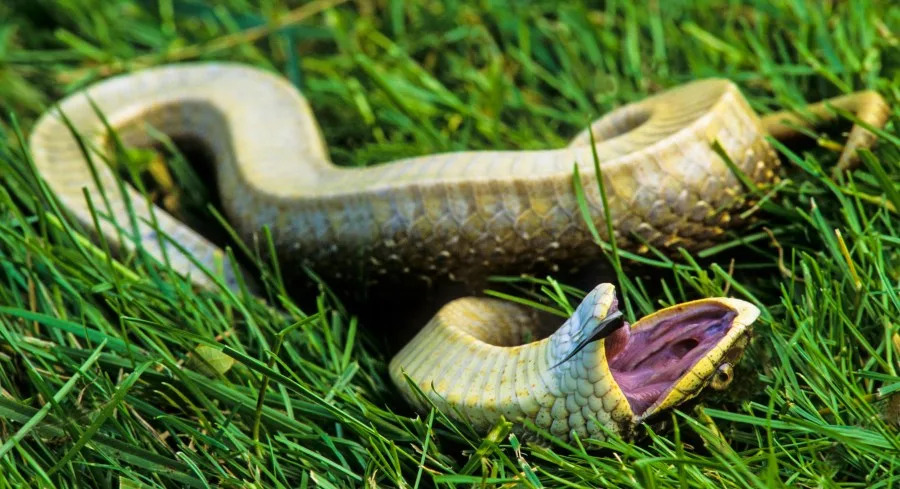
LEXINGTON, Ky. (FOX 56) — What are the most common snakes found in Kentucky, and which ones should you be aware of potentially biting you?
FOX 56 News has compiled a list of common snakes found in Kentucky, as well as ways to identify each species based on its appearance and geography.
Kentucky is home to 33 snake species, of which four pose a medical threat to healthy humans.
Rare giant salamander found in eastern Kentucky stream: What experts say it means for the ecosystem
If you have located a snake and need it identified, the University of Kentucky’s Department of Forestry and Natural Resources offers a Snake ID tool on its website.
Venomous snakes
According to the National Institute for Occupational Safety and Health, the U.S. sees between 7,000 and 8,000 snake bites a year, with 0.2% being fatal, about 5 snake bite deaths annually. However, the institute said people are more likely to suffer lasting injuries, such as losing a finger or the ability to use it.
Research from the National Library of Medicine has shown that venomous snakes do not always use their venom when biting, resulting in a “dry bite” and greatly reducing the risk of complications.
“While venomous snakes should be respected and approached with caution, most snakes encountered in Kentucky are harmless and beneficial because they eat mice and other rodents,” the University of Kentucky’s Department of Forestry and Natural Resources says.
Copperhead
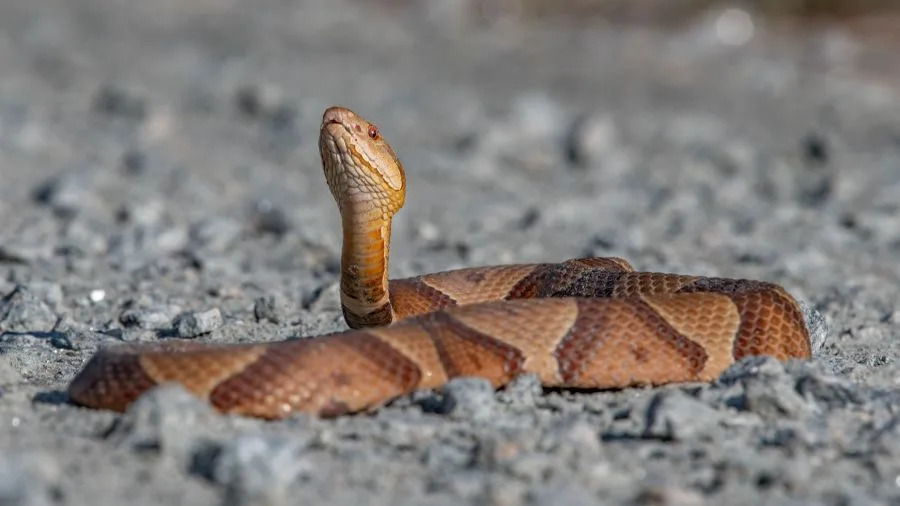
UK’s Department of Forestry and Natural Resources describes copperheads as nonaggressive animals that prefer to hide from threats but can bite if provoked.
Copperheads are stocky snakes that range from less than two feet to 4 feet as adults.
Their signature copper colored head, vertically oriented pupils, and facial pits can make them easy to distinguish from other snakes, but you can also look for a back ranging from copper-red to brown, an hourglass shape, and chestnut-colored bands across their backs.
Juvenile copperheads tend to have a yellow-greenish tail tip and a pale brown belly.
LATEST KENTUCKY NEWS:
Copperheads are found in every region of Kentucky and feed on small mammals, frogs, lizards, birds, and insects.
The Poison Control website says their bites can cause local pain, swelling, redness, bruising, blistering, low blood pressure, and bleeding, but serious complications are rare.
If bitten, it is recommended to stay calm, immobilize the bite area, and seek medical assistance.
If a pet, usually a dog, is bitten, it can be more serious but usually nonfatal. The American Society for the Prevention of Cruelty to Animals recommends seeking immediate veterinary care, where a provider will provide supportive care and check if antivenin is needed.
Pygmy rattlesnake
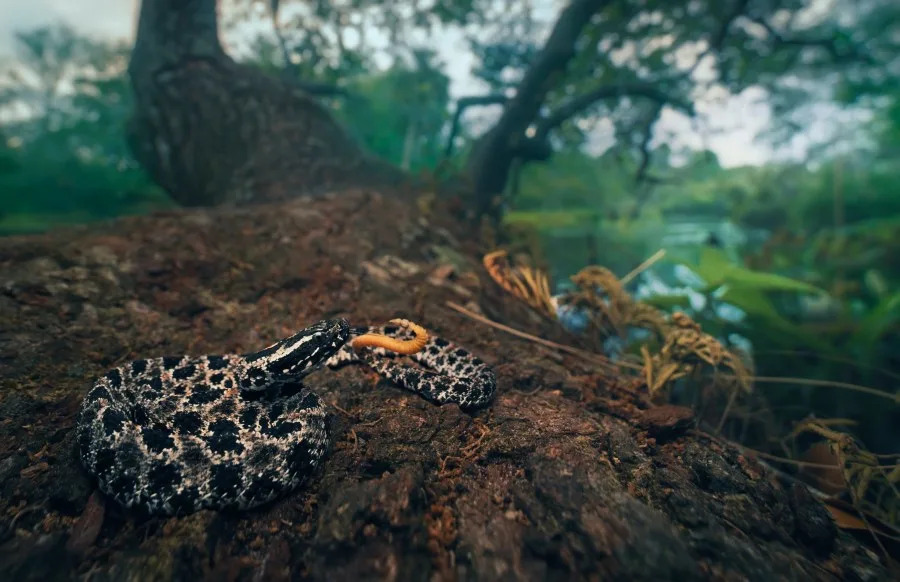
UK’s Department of Forestry and Natural Resources describes pygmy rattlesnakes as small snakes with gray to grayish brown backs, with dark oval-shaped spots, and sometimes having a reddish stripe running down their backs. They have a skinny tail and a small rattle that can sound like a buzzing insect.
Juvenile pygmy rattlesnakes often look like their adults, but with a yellow-tipped tail.
Pygmy rattlesnakes are found in Western Kentucky near the Tennessee border in Calloway, Lyon, and Trigg counties, according to Kentucky Fish and Wildlife. Fish and Wildlife said little is known about their habitats in Kentucky, but they can typically be found near water and eat mice, lizards, other small snakes, and frogs.
LATEST KENTUCKY LISTS AND RANKINGS:
Research shows bites from pygmy rattlesnakes often lead to hospitalization and tissue necrosis but aren’t usually fatal to humans. Bites can cause severe pain, swelling, blistering, and tissue damage.
Bites in animals are serious but not always fatal, depending on the animal’s size. The American Society for the Prevention of Cruelty to Animals recommends seeking immediate veterinary care, where a provider will provide supportive care and check if antivenin is needed.
Timber rattlesnake
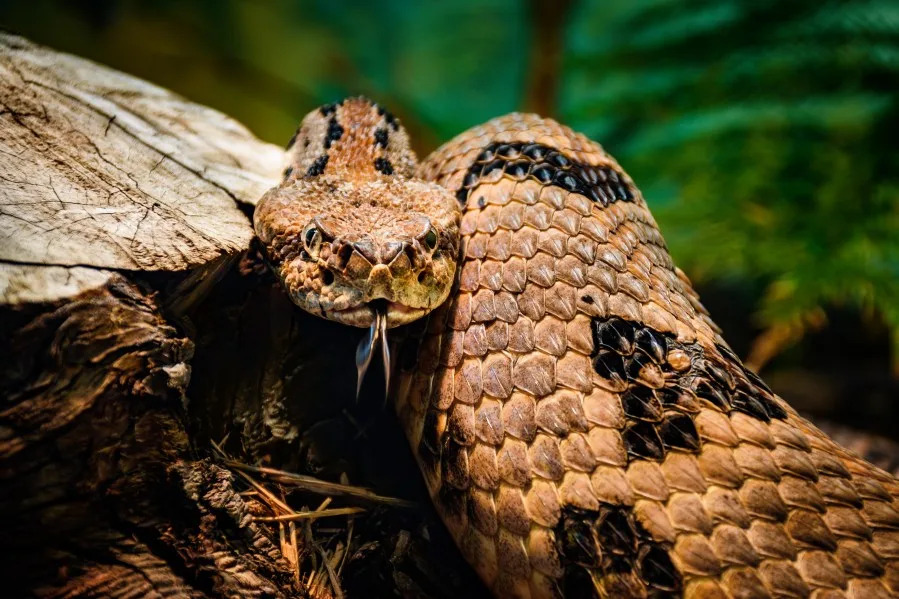
UK’s Department of Forestry and Natural Resources identifies timber rattlesnakes, sometimes called water moccasins, by their stocky build and prominent rattle. Their dorsal color can be gray, yellow, brown, or green, with most patterned with dark crossbands or chevrons that run along the back. But the department said some timber rattlesnakes are completely black.
Timber rattlesnakes are found widely in Kentucky, except in north-central Kentucky, and prefer heavily wooded areas, according to Kentucky Fish and Wildlife.
UK’s Department of Forestry and Natural Resources said timber rattlesnakes are the largest venomous snake in Kentucky, with adults reaching up to 5 feet in length, but most adults range from 2.5 to 3.5 feet.
“Timber Rattlesnakes are a true sign of wilderness. In Kentucky, these secretive and nonaggressive animals most frequently occur in areas with low human population densities,” UK’s Department of Forestry and Natural Resources said.
Smithsonian’s National Zoo & Conservation Biology Institute calls timber rattlesnake bites a medical emergency and recommends immediate medical intervention.
The Poison Control website says their bites can cause local pain, swelling, redness, bruising, blistering, low blood pressure, and bleeding, but serious complications are rare.
Kentucky residents warned: Common spiders to watch out for this spring
Bites in animals are serious but not always fatal, depending on the animal’s size. The American Society for the Prevention of Cruelty to Animals recommends seeking immediate veterinary care, where a provider will provide supportive care and check if antivenin is needed.
Western cottonmouth or water moccasin
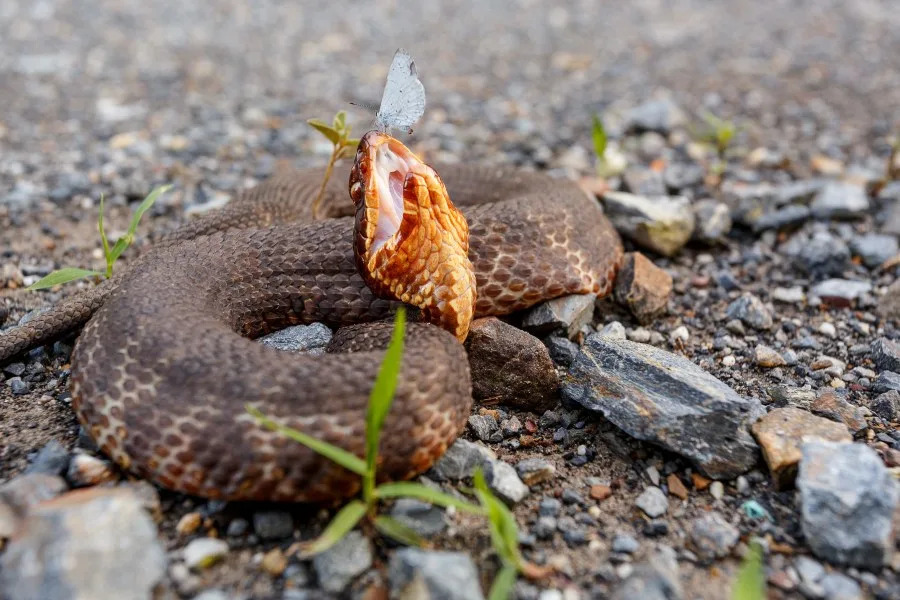
UK’s Department of Forestry and Natural Resources identifies Western cottonmouths as stocky snakes with a dark brown to black back. Some have dark crossbands on the back overlaying a brown background. Their bellies are usually patterned with irregular-shaped brown and yellow blotches.
Baby cottonmouths are lighter in color, and the dark crossbands are prominent. Babies also have a yellow or green tail tip.
Western cottonmouths are found in Western Kentucky, usually in swamps, wetlands, lakes, and flood plains during the warmer months. During spring and fall, they are often found in upland habitats far from aquatic habitats.
UK’s Department of Forestry and Natural Resources said no verified cottonmouth records have happened outside of Western Kentucky, but they are sometimes confused with watersnakes. The two are differentiated by their behavior. Cottonmouths usually swim with their heads out of the water, but watersnakes will swim with their heads at the water’s surface.
“Additionally, Cottonmouths often vibrate their tails when aggravated; Watersnakes never vibrate their tails. Finally, Cottonmouths are named for the “open-mouth” defensive gape they give when approached, which shows the white lining of their mouth. Watersnakes rarely gape,” the department said.
16 live snakes found in passenger’s belongings, seized at Mumbai airport
According to Poison Control, cottonmouth bites usually result in pain and swelling, and sometimes nausea, vomiting, low platelets, and abnormal blood clotting, but with any venomous snake bite, people should seek medical advice immediately.
Bites in animals are serious but not always fatal, depending on the animal’s size. The American Society for the Prevention of Cruelty to Animals recommends seeking immediate veterinary care, where a provider will provide supportive care and check if antivenin is needed.
Nonvenomous snakes
According to the Cleveland Clinic, a nonvenomous snake bite can cause mild swelling, changes in skin color like redness, or the darkening of the skin, and light bleeding. Venomous bites usually will cause more pain, heavy bleeding, sweating, difficulty breathing, headaches, dizziness, and nausea and vomiting.
The Cleveland Clinic said some people can also experience allergic reactions to snake bites, which can cause throat tightness, a swollen tongue, difficulty speaking, pale skin, and coughing or wheezing.
Broad-banded watersnake

Kentucky Fish and Wildlife said the broad-banded watersnake is found in the far Western part of the state in aquatic habitats.
According to UK’s Department of Forestry and Natural Resources, broad-banded watersnakes range from 2 to 3 feet long with wide, dark brown crossbands along a reddish-colored body. The belly is yellow with square spots. They also have a dark brown stripe extending from behind the eye onto the neck.
‘She’s a miracle’: Toddler bitten twice by rattlesnake, receives over 30 vials of antivenom
They feed on small fish and amphibians and are hunted by cottonmouths and herons.
Common garter snake or eastern garter snake
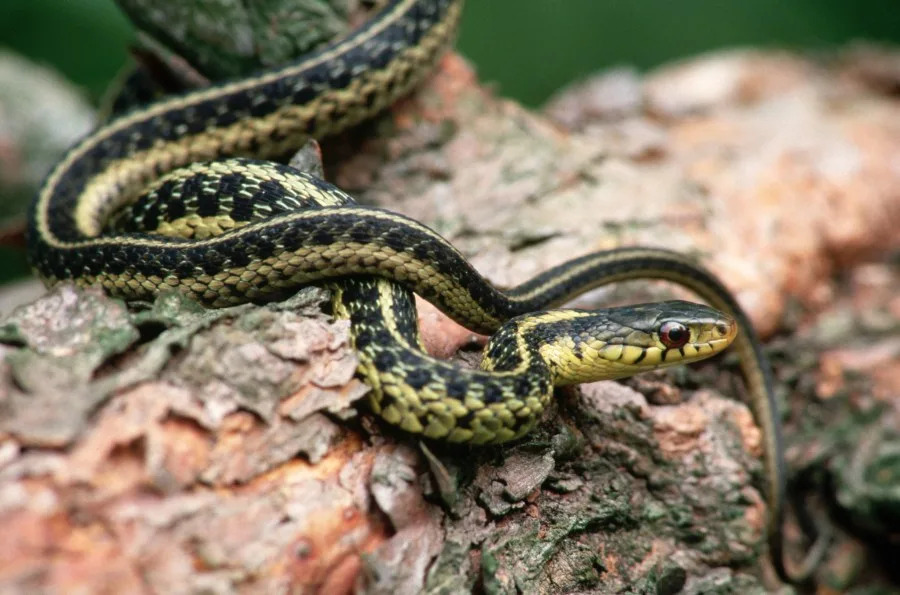
Kentucky Fish and Wildlife said the eastern garter snake is found all over Kentucky in urban areas.
According to UK’s Department of Forestry and Natural Resources, eastern garter snakes are usually under 2 feet long with one or two lateral cream, yellowish, or greenish stripes. Their bellies can be pale yellow or greenish with black spots on their belly scales.
Juveniles typically feed on bugs and salamanders, while adults eat frogs, toads, mice, and nesting birds.
Eastern garter snakes are usually considered harmless, but can release a pungent musk when handled and can sometimes bite.
Common or northern watersnake
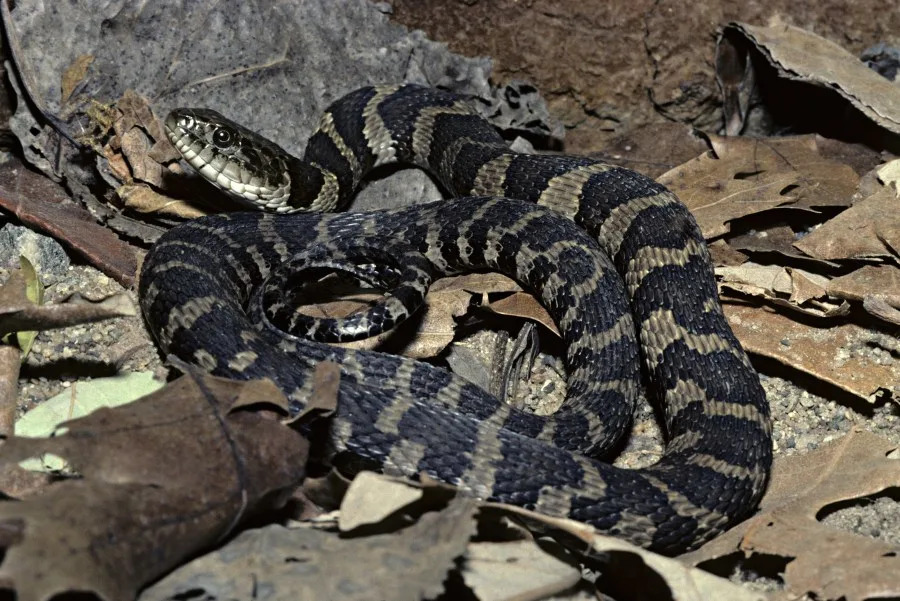
Kentucky Fish and Wildlife said the northern watersnake is found in nearly every body of water in Kentucky, including streams in suburban and urban areas.
“These aquatic snakes nearly always make a hasty retreat into water when approached,” Kentucky Fish and Wildlife said.
According to UK’s Department of Forestry and Natural Resources, northern watersnakes can reach 3 to 4 feet and are highly variable in color, pattern, and shape. Their backs are usually brown, gray, or black with reddish brown to light brown spots or bands along the body.
Watch: Man finds approx. 8-foot snake hiding in his Colorado office
The department said northern watersnakes are often confused with cottonmouths, but any heavy-bodied, aquatic snakes in central or eastern Kentucky are likely northern watersnakes.
These snakes will bite and release a musk if threatened.
Common Wormsnake
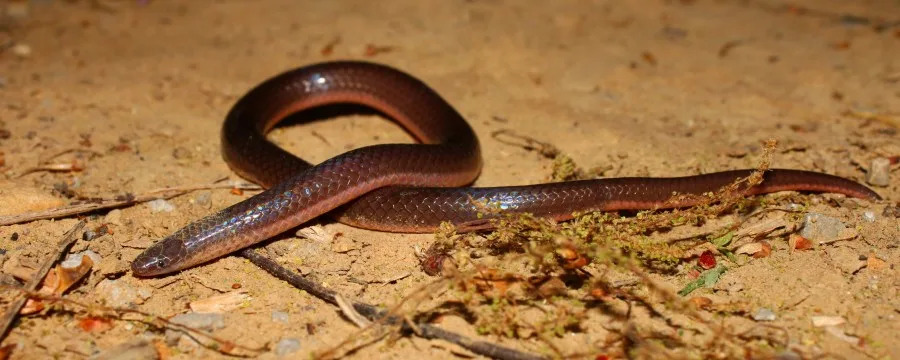
Kentucky Fish and Wildlife said worm snakes are found nearly everywhere in Kentucky except for north-central Kentucky. They like moist, deciduous forests and usually live under rocks, inside decaying logs, and under leaf litter.
According to UK’s Department of Forestry and Natural Resources, worm snakes range from 7 to 11 inches with brown to grayish backs and a light pink or white belly. Their small head is pointed, and their tails have a small, harmless spine. They appear smooth and glossy, like worms with tiny eyes.
Worm snakes don’t bite, but will release musk when disturbed and try to poke their captor with their tail.
Dekay’s brownsnake
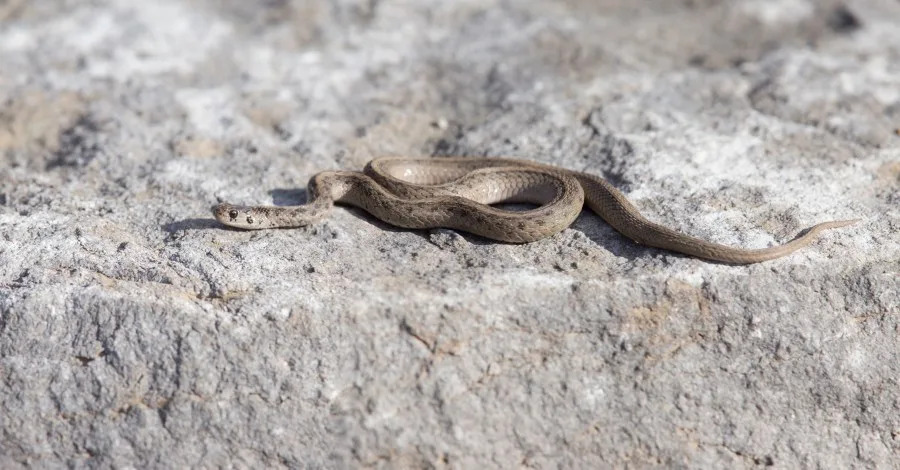
Kentucky Fish and Wildlife said brown snakes are widely found in Kentucky, but absent in the Inner Bluegrass Region and parts of the Cumberland Plateau.
According to UK’s Department of Forestry and Natural Resources, brown snakes are about 13 inches long and have a brown to grayish-brown dorsum with a pale stripe with small black spots running along the middle of the back.
Brown snakes are usually encountered in suburban gardens and yards, and sometimes mistaken for copperheads, but brown snakes don’t bite and instead release musk when threatened.
WATCH: The number of snakes removed from one Australian yard will make you shudder
They are nocturnal snakes and eat earthworms, snails, slugs, salamanders, and beetles, and are preyed on by birds, mammals, and other snakes.
Diamond-backed water snake
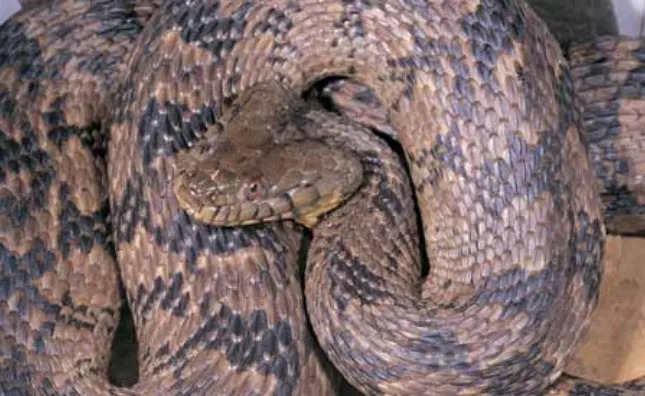
Kentucky Fish and Wildlife said diamond-backed water snakes are another large, stocky species found in Western Kentucky near the Jackson Purchase and Western Kentucky coalfields, within or around any aquatic habitats.
According to UK’s Department of Forestry and Natural Resources, diamond-backed water snakes are about 3 feet long and have diamond-shaped blotches on their back and sides. Their background color is usually brown, but can be yellowish or greenish.
The department said diamond-backed water snakes will bite and expel a pungent musk when handled.
Eastern Black Kingsnake
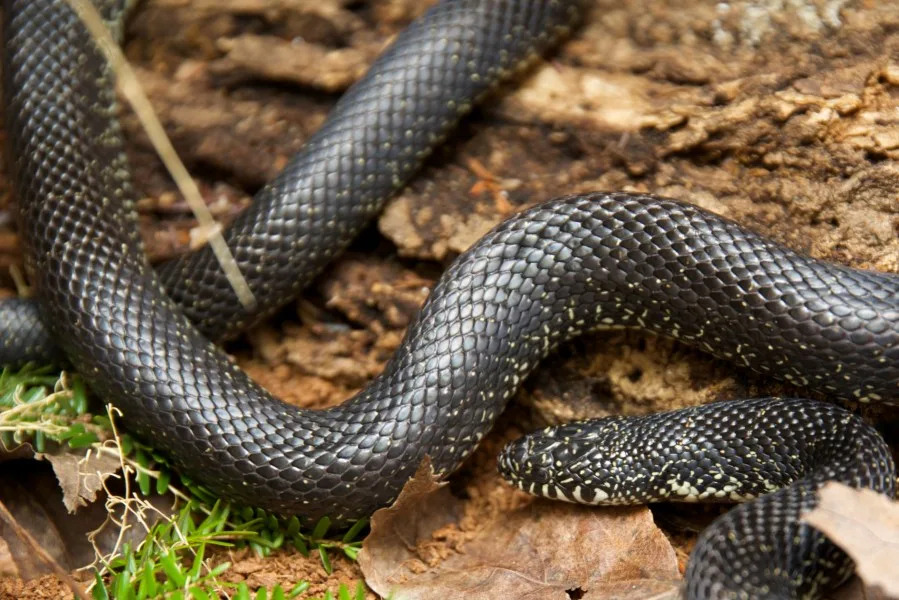
Kentucky Fish and Wildlife said black king snakes are found in most of Kentucky, except for a small portion of eastern Kentucky and northern Kentucky.
According to UK’s Department of Forestry and Natural Resources, these king snakes are moderately stocky blacksnakes with small yellowish spots on their heads and backs. Black king snakes also have black bellies with white checkered patterns.
Black king snakes mostly eat other snakes, including venomous ones. Researchers said black king snakes are immune to pit viper venom.
Black king snakes will vibrate their tail, release musk, and bite if threatened.
Eastern hognose snake
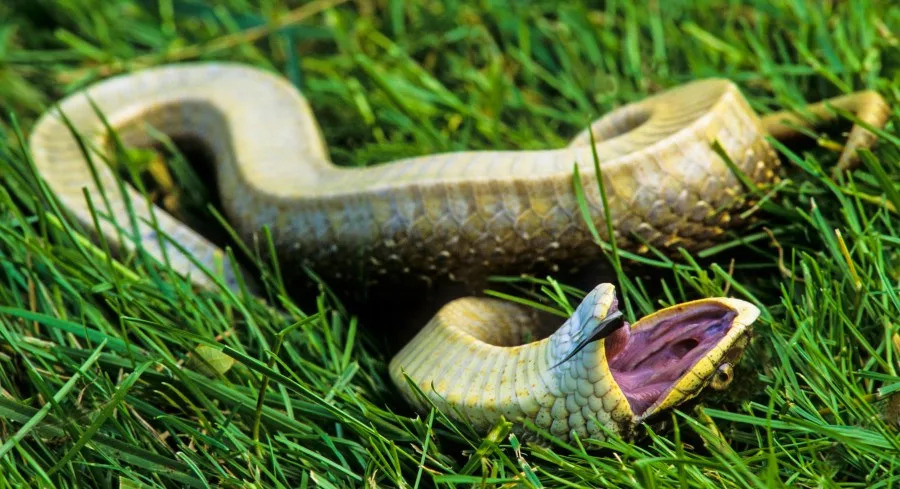
Kentucky Fish and Wildlife said eastern hog-nosed snakes are found in every corner of Kentucky in a variety of habitats, such as fields, forests, and around wetlands.
According to UK’s Department of Forestry and Natural Resources, eastern hog-nosed snakes are characterized by an upturned snout scale that is reminiscent of a “hog’s nose.” Their dorsal color can be black, gray, yellow, dark green, and even red, and they sometimes have rectangular spots.
Eastern Hog-nosed Snakes rarely bite, but have a flair for the dramatic. If provoked, they will puff out their throat and hiss, regurgitate their meal, release musk, defecate, and sometimes pretend to be dead.
Eastern milksnake
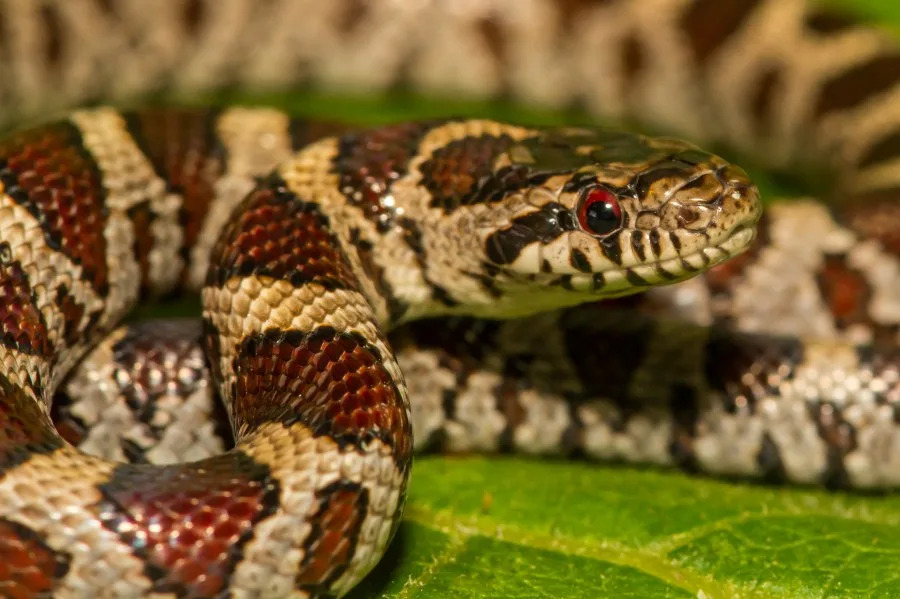
Kentucky Fish and Wildlife said eastern milk snakes are found all over Kentucky.
UK’s Department of Forestry and Natural Resources describes these snakes as ranging from light brown to gray with black-edged, red to reddish-brown blotches down the back
“Because of their common occurrence within barns, many people believe that Milksnakes suck milk from cows (hence the common name “Milksnake”). However, this is a myth. Snakes (and all reptiles) cannot digest lactose, and we doubt cows would tolerate being milked by a snake,” reads the department’s website.
These nonvenomous snakes will vibrate their tails, release musk, strike, and bite if threatened.
Eastern ribbon snakes
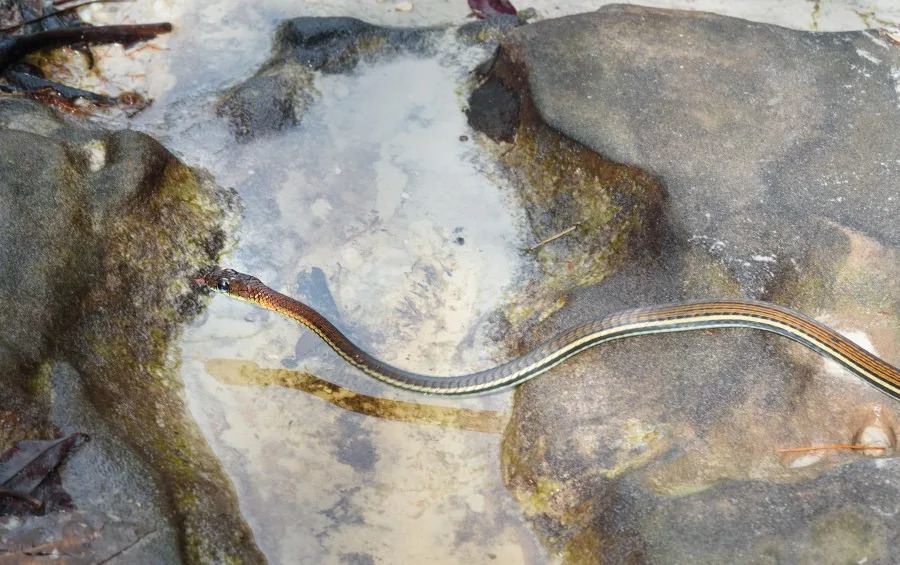
Kentucky Fish and Wildlife said eastern ribbon snakes are found in Western Kentucky, with small populations in west-central and northeastern Kentucky.
UK’s Department of Forestry and Natural Resources describes these snakes as having a gray to black dorsum with three yellowish stripes.
Eastern ribbon snakes mostly eat amphibians and small fish, and will release musk and slither into water to escape danger.
Gray ratsnake, black ratsnake
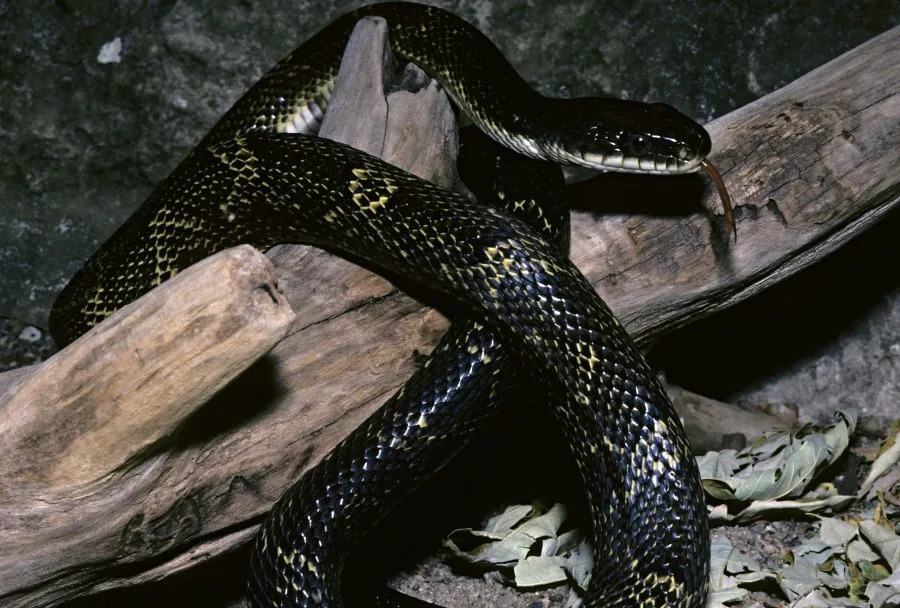
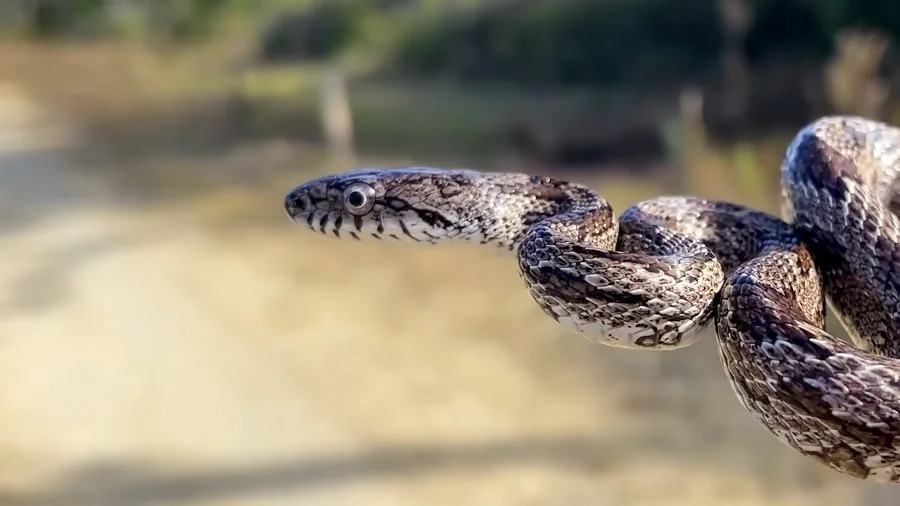
UK’s Department of Forestry and Natural Resources said gray ratsnakes are found all over Kentucky, in a variety of habitats, and usually have black, gray, or brownish-black dorsal color. They can also have yellowish-brownish blotches.
Kentucky Fish and Wildlife said black ratsnakes are also found all over Kentucky and are described as being a brown to black, sometimes having a cream or yellowish coloring “between” its scales.
Both snakes eat small mammals like mice, but prefer birds and eggs.
Winner of Florida’s Python Challenge removes 20 invasive snakes, earns big cash prize
UK’s Department of Forestry and Natural Resources said these snakes likely play important roles as predators, potentially controlling rodent populations, but might be a nuisance for some due to their love of chicken and duck eggs.
Kirtland’s Snake
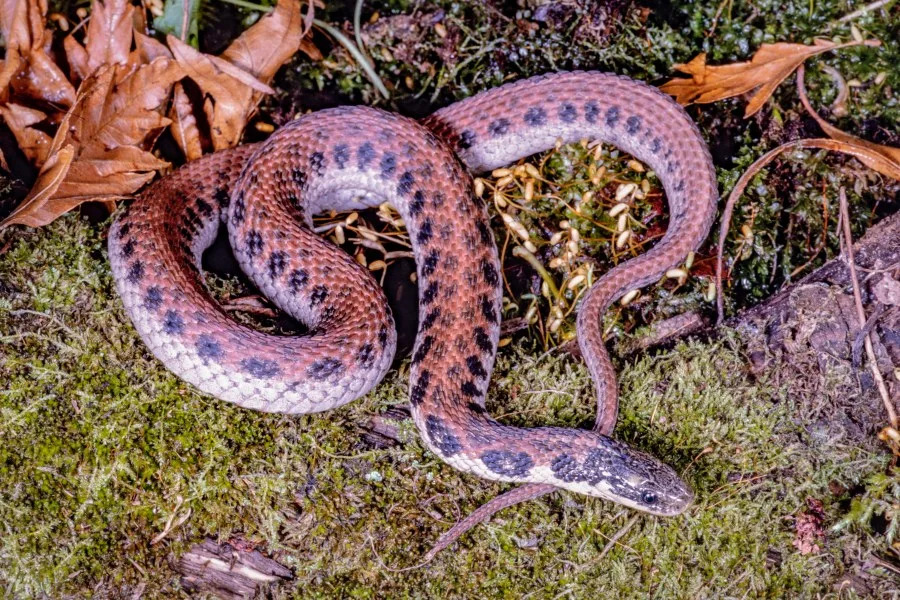
UK’s Department of Forestry and Natural Resources said kirtland’s snakes are somewhat stout grayish to reddish brown snakes with a red to pink belly.
They sparsely populate sections of the Ohio River in northern Kentucky and Louisville, with a small population in the Jackson Purchase.
Mississippi green water snake
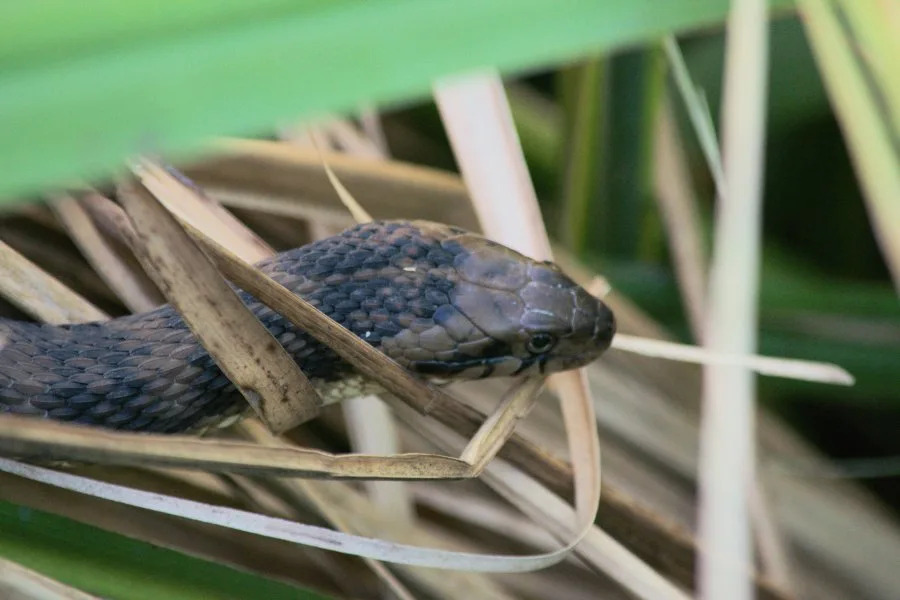
Kentucky Fish and Wildlife said the Mississippi green water snake is another water snake found in far Western Kentucky.
UK’s Department of Forestry and Natural Resources describes them as green to gray back with a dark-colored belly covered with pale yellow spots.
Reportedly, the snakes will typically try and escape danger, but will release musk and bite if captured.
North American Black Racer
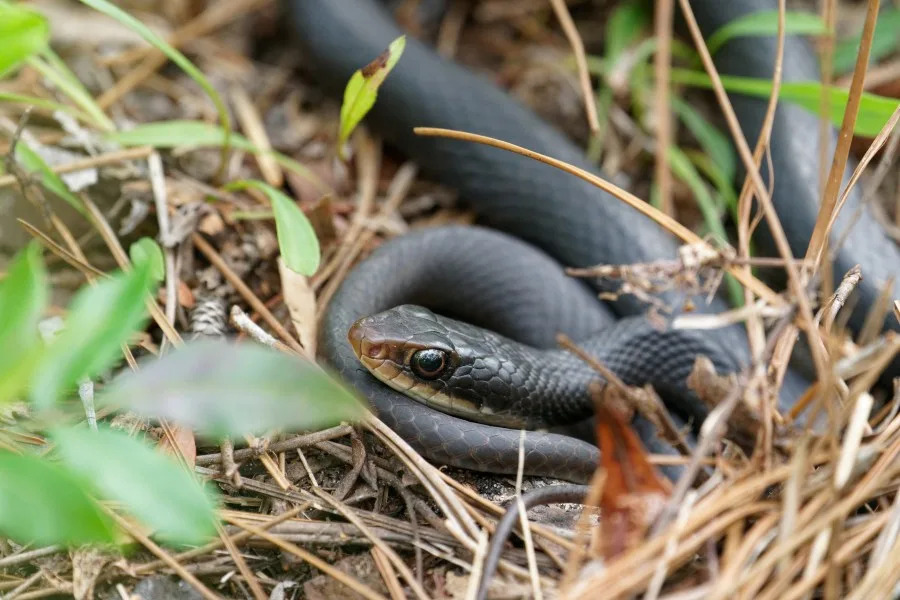
Kentucky Fish and Wildlife said black racers are found all over Kentucky.
UK’s Department of Forestry and Natural Resources describes them as black to blue-gray snakes with a white patch on their chin and throat.
‘Mega den’ of hundreds of rattlesnakes grows in Colorado as births captured live
Black racers usually flee from danger, but will vibrate their tails and bite if escape isn’t an option.
Pine snake
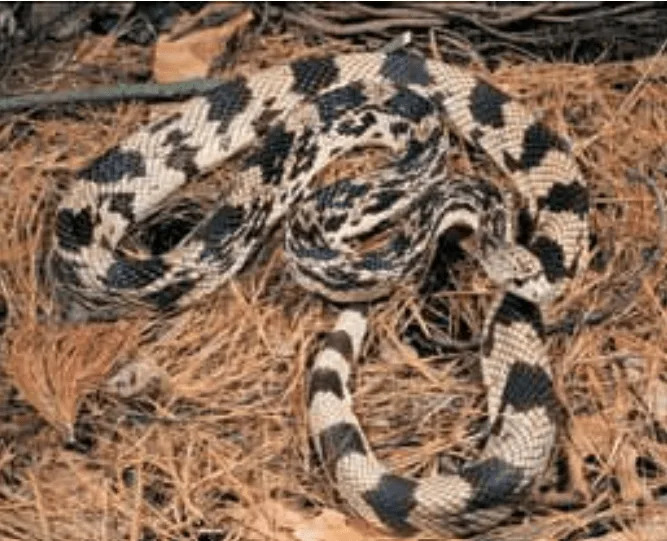
UK’s Department of Forestry and Natural Resources said pine snakes have limited populations in Kentucky, mostly in the Land Between the Lakes National Recreation Area, southeastern Kentucky, and south-central Kentucky, where they live in woodlands, abandoned agricultural fields, and places with dry, sandy soil.
They are described as being a heavy snake with a whitish to yellowish dorsum with black blotches.
Pine snakes often hiss loudly when encountered, but are considered harmless, according to the department.
Copperbelly water snake and yellowbelly watersnakes
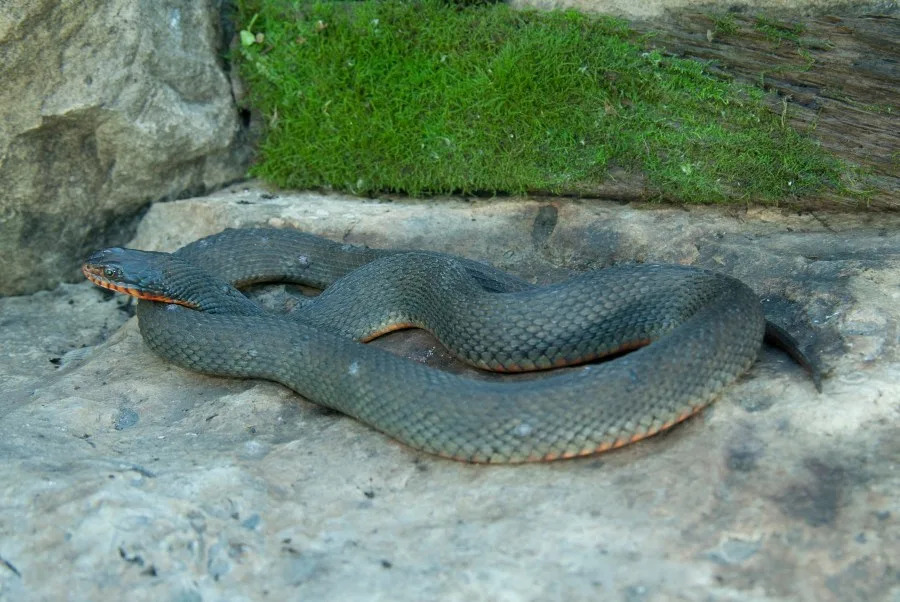
UK’s Department of Forestry and Natural Resources said both copperbelly water snakes and yellowbelly water snakes are found in Western Kentucky.
Copperbelly water snakes are all black with a red-orange belly.
Yellowbelly water snakes have a gray to greenish back and an unpatterned, yellow belly
Both subspecies of the plainbelly watersnakes will musk and bite if threatened.
Queen snake

UK’s Department of Forestry and Natural Resources said queen snakes are mostly found in central Kentucky, near rocky streams and rivers.
They are usually light brown, olive green, or gray-black, with black lines on their sides.
Queen snakes rarely bite, but will release musk if captured.
Corn snake
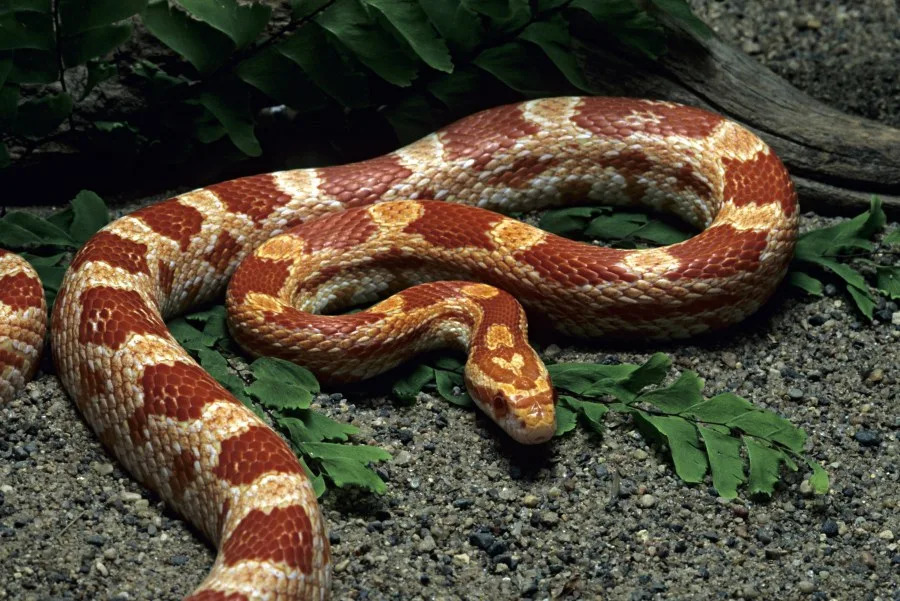
Kentucky Fish and Wildlife said corn snakes have limited populations near the eastern and Western edges of central Kentucky.
They can be orange, brown, or gray with orange or reddish blotches with black borders.
Corn snakes will sometimes vibrate their tail or bite if threatened, but usually try to escape if possible.
Red-bellied mud snake, Western mud snake
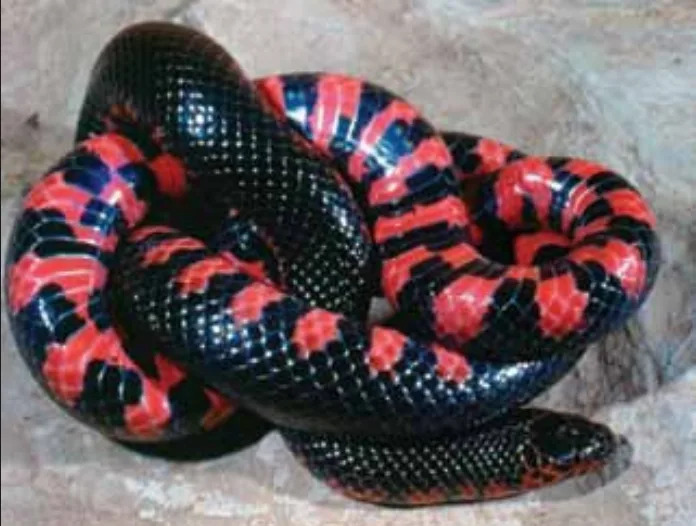
Kentucky Fish and Wildlife said these snakes are found in Western Kentucky swamps.
UK’s Department of Forestry and Natural Resources said these snakes are stocky blacksnakes with red and black checkerboard bellies.
Mudsnakes don’t bite, but they will release musk and poke the captor with the tail.
Northern redbelly snake
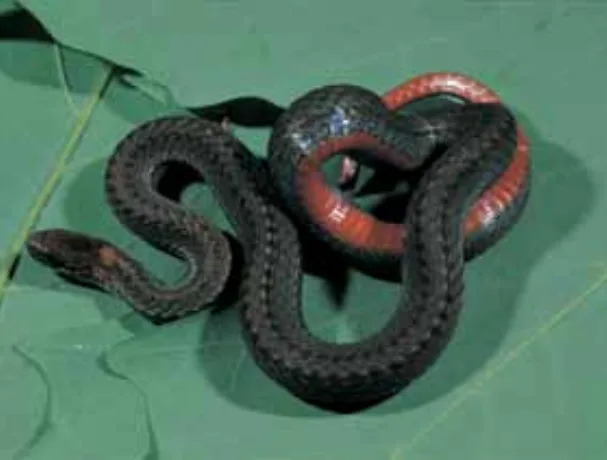
Kentucky Fish and Wildlife said these snakes can be found in most of Kentucky, except for portions of northern and Western Kentucky.
UK’s Department of Forestry and Natural Resources said these snakes are known for their crimson-red to orange bellies, but their backs can range from dark gray to reddish-brown.
Watch: Rattlesnake, bobcat square off in heated desert battle
Northern redbelly snakes usually release musk and play dead when threatened.
Ringneck snake
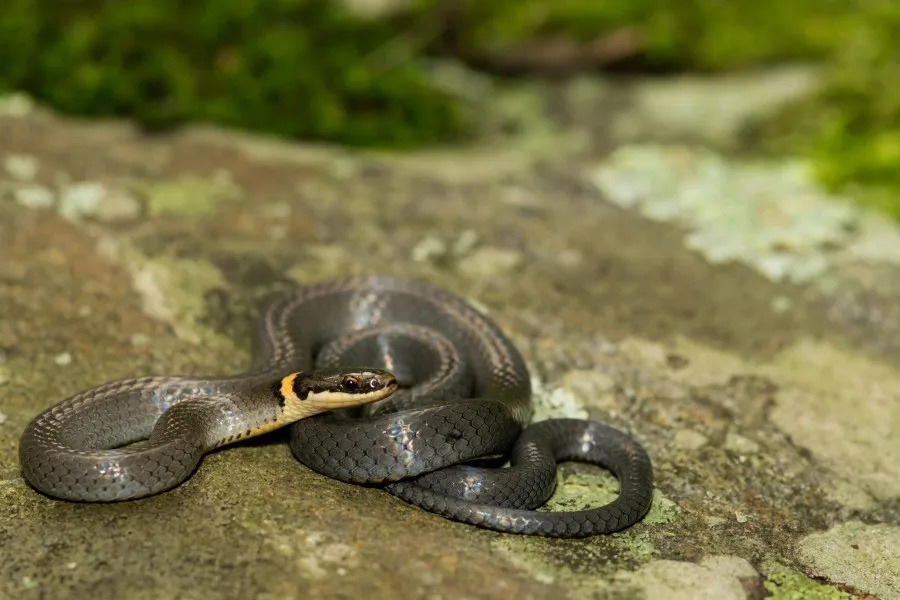
Kentucky Fish and Wildlife said ringneck snakes can be olive, greenish-gray, blue-black, or black with yellow, orange, or red bellies and a light colored ring around their neck.
UK’s Department of Forestry and Natural Resources said they can be found throughout Kentucky and usually eat earthworms, slugs, small salamanders and frogs, birds, and other snakes.
The department said ringneck snakes do have toxic saliva used to paralyze prey, but they are harmless to humans.
Rough green snake
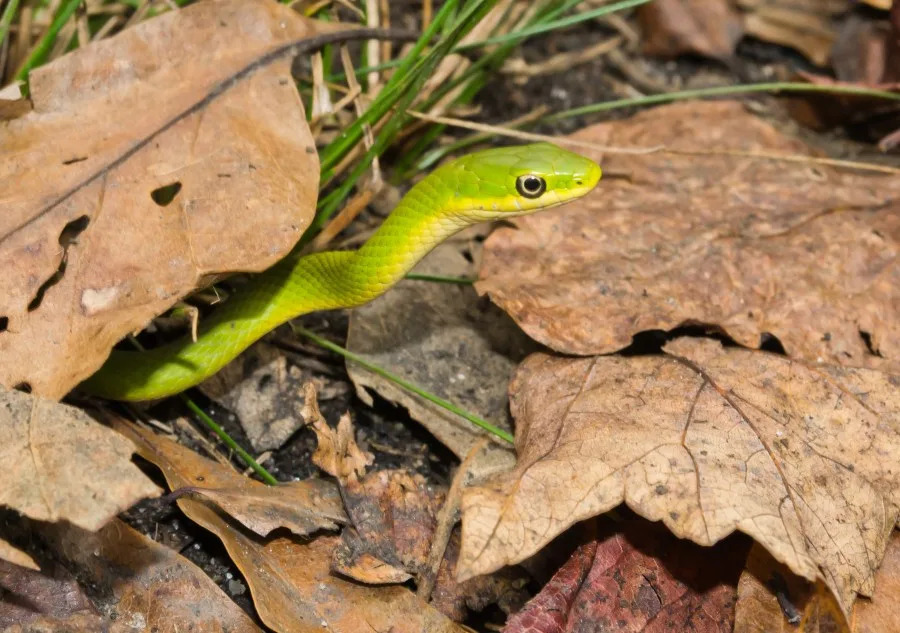
Kentucky Fish and Wildlife said rough green snake can be found all over Kentucky.
UK’s Department of Forestry and Natural Resources said rough green snakes are slender green snakes with a yellowish to white belly.
These snakes rely on camouflage as their primary defense and feed on grasshoppers, crickets, and spiders.
Scarlet king snake
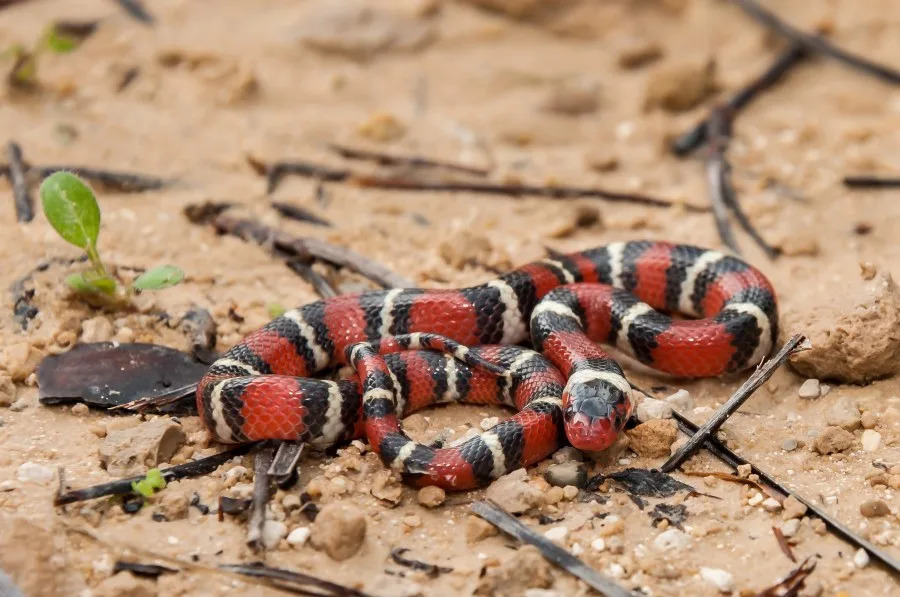
Kentucky Fish and Wildlife said scarlet king snakes are uncommon snakes found along Kentucky’s eastern and southern borders.
According to UK’s Department of Forestry and Natural Resources, scarlet king snakes are colorful snakes with bands of red, black, and yellow.
Scarlet king snakes are nonvenomous, but can be confused with the venomous eastern coral snake, which isn’t found in Kentucky.
The department said scarlet king snakes are popular pets among snake lovers.
Scarletsnake
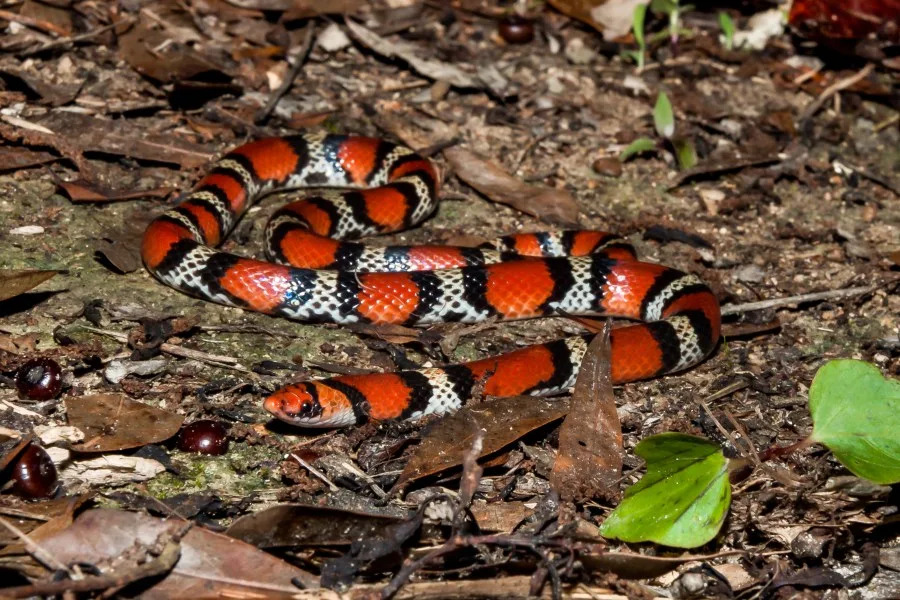
Kentucky Fish and Wildlife said scarlet snakes, while uncommon, can be found in Western and central Kentucky.
According to UK’s Department of Forestry and Natural Resources, scarlet snakes are slender to moderate-sized snakes with red, black, and yellow bands, and a white belly.
Scarlet snakes are nonvenomous, but can be confused with the venomous eastern coral snake, which isn’t found in Kentucky.
Smooth earth snake
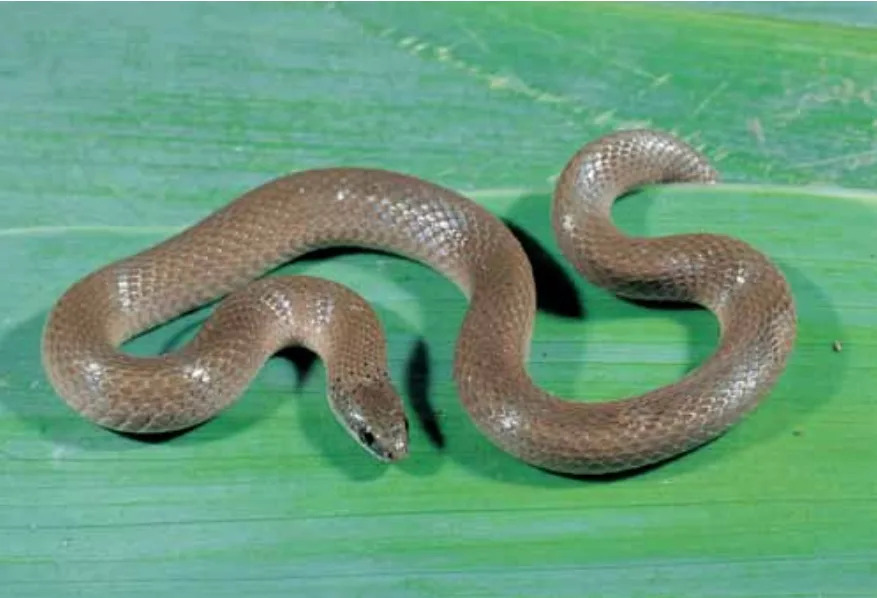
Kentucky Fish and Wildlife said the smooth earth snake is found in portions of eastern and Western Kentucky.
According to UK’s Department of Forestry and Natural Resources, smooth earth snakes are brown to brownish-gray with a light-colored belly and small heads.
Smooth earth snakes eat earthworms and soft-bodied invertebrates and don’t bite, but will release musk if threatened.
Southeastern crowned snake
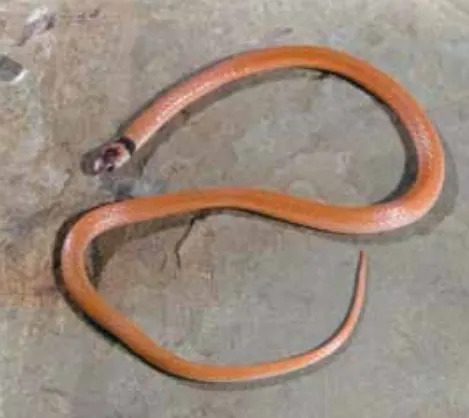
UK’s Department of Forestry and Natural Resources said the southeastern crowned snake is found in Western Kentucky woodlands.
They are described as having a slender, unpatterned tan or dark brown body. Southeastern crowned snakes have a black or dark brown “crown” on their heads, and a dark-colored collar on the neck.
They are considered completely harmless to humans despite having venom glands and rarely attempting to bite.
Western ribbon snake
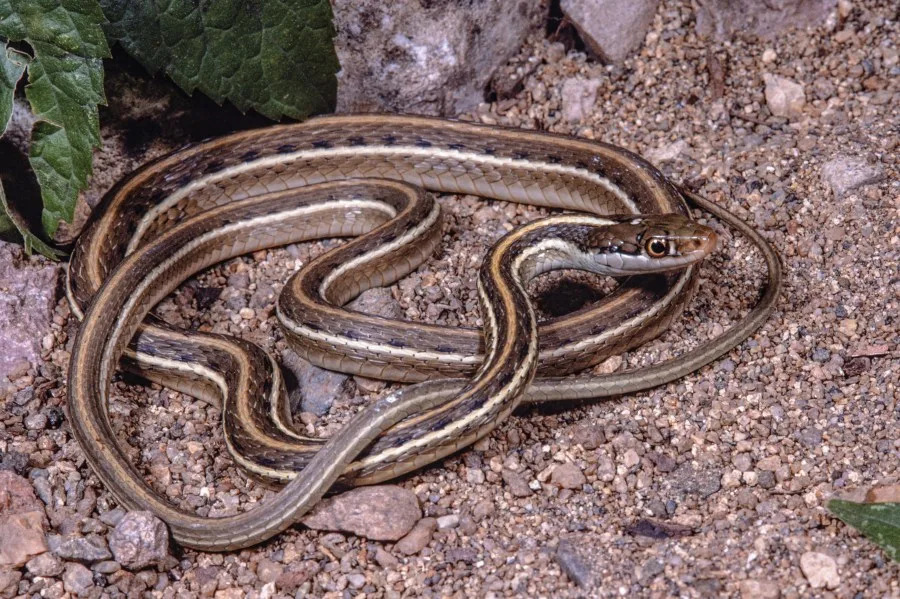
Kentucky Fish and Wildlife said the Western ribbon snake is found in the extreme Western portions of Kentucky.
According to UK’s Department of Forestry and Natural Resources, Western ribbon snakes are slender gray to blacksnakes with three yellowish stripes.
They typically eat amphibians and small fish.
Yellow-bellied or prairie king snake
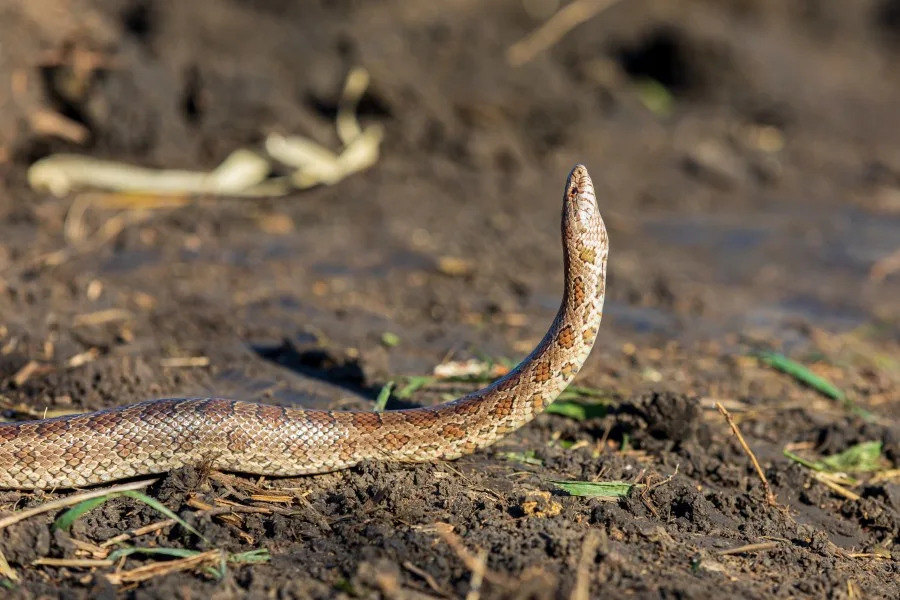
Kentucky Fish and Wildlife said these snakes can be found in grasslands, old fields, pastures, and open woods in Western Kentucky.
According to UK’s Department of Forestry and Natural Resources, prairie king snakes are moderately sized brown-gray snakes with brown to reddish blotches.
‘Very scary’: Texas woman says she was bitten by snake in her toilet
Prairie king snakes vibrate their tails, release musk, and bite if threatened.
Copyright 2025 Nexstar Media, Inc. All rights reserved. This material may not be published, broadcast, rewritten, or redistributed.
For the latest news, weather, sports, and streaming video, head to FOX 56 News.




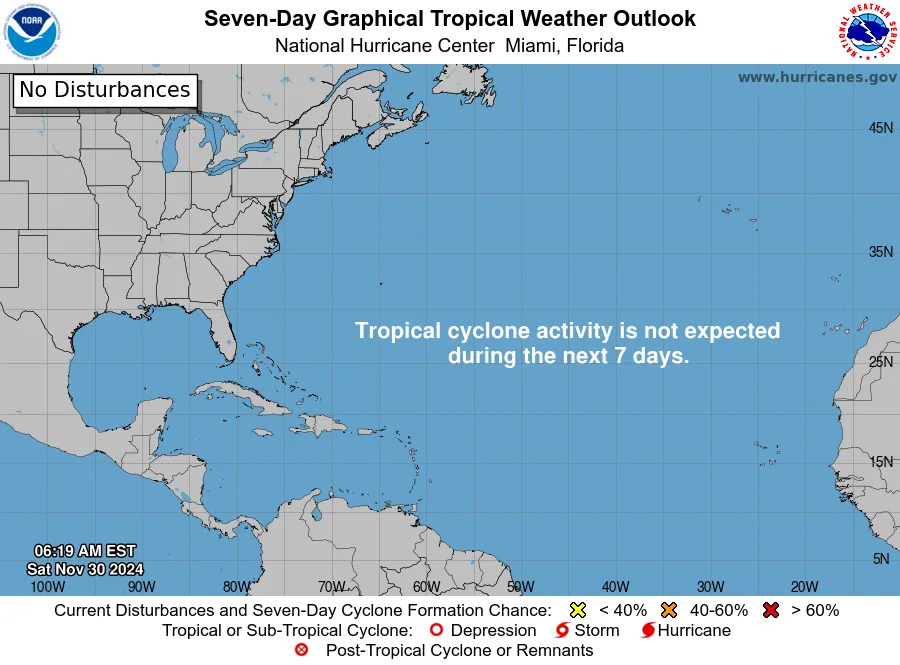

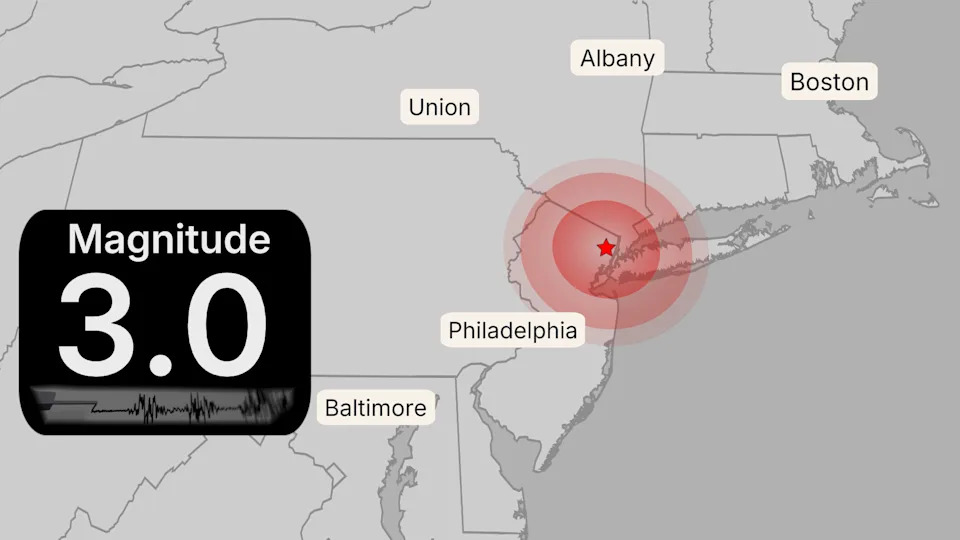

Comments